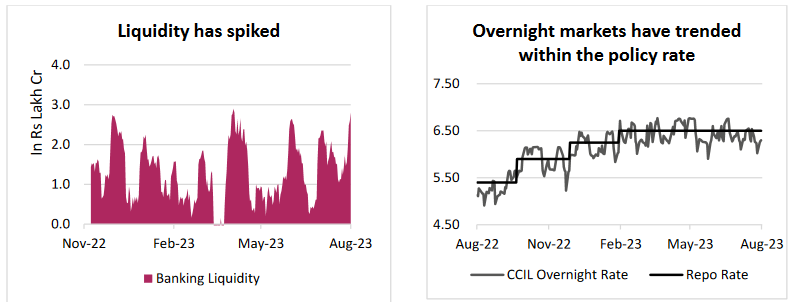RBI Monetary Policy: Read between the lines
Mutual Fund
With inflation as the top agenda for the central bank, the MPC action today can be perceived as a tad ‘hawkish’. Uncertainty on account of El-Nino patterns and external forces are likely factors affecting the MPC’s thought process. The big story was a surprise CRR action on incremental deposits raising eyebrows across market participants.
Policy Decision
- Repo rate unchanged at 6.5%
- SDF rate unchanged at 6.25% and MSF rate unchanged at 6.75%
- All six members voted in favor of the pause.
- Five members voted to “remain focused on withdrawal of accommodation to ensure inflation progressively aligns with the target, while supporting growth”. Dr Varma voted against the stance.
- Incremental CRR of 10% on scheduled banks’ deposits on deposits made between May 19 and July 28, 2023
CRR Shocker
Expressing subtle displeasure at the banking sector, the RBI has instituted an incremental CRR of 10% on deposits made between May 19 and July 28, 2023. The RBI committed to review the action on or before 8th Sep 2023.
The use of CRR to combat temporary liquidity, in our view, is excessive and unjustified. Impounding ‘return – accretive’ assets which would otherwise get deployed in the overnight markets is akin to penalizing banks for their lukewarm participation in VRRR auctions. The commercial decision of banks to deploy assets in higher yielding overnight markets could be perceived as harsh.
The current size1 of the NDTL book across scheduled commercial banks is ~Rs. 197 lakh Cr on which banks hold 4.5% CRR as per existing norms. Implementation of the i-CRR would mean an immediate liquidity reduction of Rs. 1 lakh Cr. This implies a 50bps CRR hike.
The increase in NDTL is largely driven by a large bank-NBFC merger and is likely to affect the merged entity. Outside this, the excess liquidity is driven by 2 factors – RBI FX interventions and the Rs. 2,000 note recall.
Further, overnight market data indicates that banks (private and PSU) are net borrowers in overnight markets. Non-bank entities, who are net liquidity surplus, are not allowed to participate in RBI reverse repo operations. Thus penalizing/impounding cash from banks is not a good idea.
This adds a new risk to the money market - at any time, RBI can take out liquidity through active CRR moves.
1 As per last published data

Source: RBI, Axis MF Research, Bloomberg. Data as of 10th August 2023.
Growth & Inflation
The governor reiterated concerns from his previous MPC statement on global growth highlighting divergent and slowing trajectories across regions amidst moderating but above target inflation, tight financial conditions, simmering geopolitical conflicts, and geoeconomic fragmentation. For several emerging market economies, weak external demand, elevated debt levels & tight external funding conditions pose risks to their growth prospects.
Domestic growth indicators for the RBI, however, give adequate comfort for the governor to retain its current estimates for the rest of the year.

Source: RBI Governor’ Statement dated 10th August 2023.
On inflation, RBI’s estimates have changed dramatically with Q2 inflation now pegged a full 1% above the June estimate citing higher food inflation and uncertainty on 2nd order inflation effects in Q3 FY24. Though the RBI believes food inflation is transitory, we anticipate RBI is being over-cautious in its approach to avoid any inflation fears keeping the upcoming festival season in mind
Market Reaction
The headline policy action was in-line with market consensus. Money markets have seen a marginal uptick of 5-10bps while corporate bonds and sovereign assets remain largely unchanged. The benchmark 10-year G-Sec stood at 7.167%.
Our View
Policy actions and commentary are in line with our view. We retain our thesis of peak rates within the current market environment. With policy rates remaining incrementally stable, we have added duration gradually across our portfolios within the respective scheme mandates.
Investors can look at actively managed strategies to capitalize from fluctuations in rate movements. While the overall call is to play flat/falling interest rate cycle over the next 18-24 months, markets are likely to see sporadic rate movements. In such a scenario, active funds are ideally positioned to toggle across duration and the ratings curve to optimize medium term returns.

Allocation and strategy is based on the current market conditions and is subject to changes depending on the fund manager’s view of the markets. Data as on 31st July 2023 *Mac Duration computed basis look through portfolios of underlying funds with a portfolio date of 30th June 2023.
Product Labelling

Disclaimer
Source of Data: RBI Governor’ Statement, RBI Monetary Policy Statement & RBI post policy press conference dated 10th August 2023, Axis MF Research
This document represents the views of Axis Asset Management Co. Ltd. and must not be taken as the basis for an investment decision. Neither Axis Mutual Fund, Axis Mutual Fund Trustee Limited nor Axis Asset Management Company Limited, its Directors or associates shall be liable for any damages including lost revenue or lost profits that may arise from the use of the information contained herein. No representation or warranty is made as to the accuracy, completeness or fairness of the information and opinions contained herein. The material is prepared for general communication and should not be treated as research report. The data used in this material is obtained by Axis AMC from the sources which it considers reliable.
While utmost care has been exercised while preparing this document, Axis AMC does not warrant the completeness or accuracy of the information and disclaims all liabilities, losses and damages arising out of the use of this information. Investors are requested to consult their financial, tax and other advisors before taking any investment decision(s). The AMC reserves the right to make modifications and alterations to this statement as may be required from time to time.
Statutory Details: Axis Mutual Fund has been established as a Trust under the Indian Trusts Act, 1882, sponsored by Axis Bank Ltd. (liability restricted to Rs. 1 Lakh). Trustee: Axis Mutual Fund Trustee Ltd. Investment Manager: Axis Asset Management Co. Ltd. (the AMC) Risk Factors: Axis Bank Limited is not liable or responsible for any loss or shortfall resulting from the operation of the scheme.
(Mutual Fund investments are subject to market risks, read all scheme related documents carefully.)
MUTUAL FUND TOOLS & CALCULATORS
Recent News
-
Mirae Asset Investment Managers (India) Pvt. Ltd. IFSC branch launches Mirae Asset Global Allocation Fund IFSC at Gift City
Apr 21, 2025
-
Axis Mutual Fund joins ONDC Network to Expand Access to Mutual Fund Investments
Apr 18, 2025
-
RBI Monetary Policy: RBI changes policy stance and lowers rate
Apr 9, 2025
-
Reciprocal Tariffs: Casting a wider net
Apr 7, 2025
-
Axis MF: Gold and Silver Outlook
Mar 17, 2025






